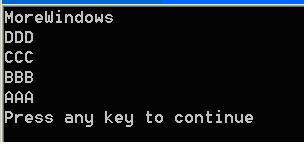C++ Primer 类 12.6 static
来源:互联网 发布:软件开发groupyf 编辑:程序博客网 时间:2024/04/29 13:39
静态成员的定义或声明要加个关键static。静态成员可以通过双冒号来使用即<类名>::<静态成员名>。
在C++中类的静态成员变量和静态成员函数是个容易出错的地方,本文先通过几个例子来总结静态成员变量和成员函数使用规则,再给出一个实例来加深印象。希望阅读本文可以使读者对类的静态成员变量和成员函数有更为深刻的认识。
第一个例子,通过类名调用静态成员函数和非静态成员函数
- class Point
- {
- public:
- void init()
- {
- }
- static void output()
- {
- }
- };
- void main()
- {
- Point::init();
- Point::output();
- }
编译出错:error C2352: 'Point::init' : illegal call of non-static member function
结论1:不能通过类名来调用类的非静态成员函数。
第二个例子,通过类的对象调用静态成员函数和非静态成员函数
将上例的main()改为:
- void main()
- {
- Point pt;
- pt.init();
- pt.output();
- }
编译通过。
结论2:类的对象可以使用静态成员函数和非静态成员函数。
第三个例子,在类的静态成员函数中使用类的非静态成员
- #include <stdio.h>
- class Point
- {
- public:
- void init()
- {
- }
- static void output()
- {
- printf("%d\n", m_x);
- }
- private:
- int m_x;
- };
- void main()
- {
- Point pt;
- pt.output();
- }
编译出错:error C2597: illegal reference to data member 'Point::m_x' in a static member function
因为静态成员函数属于整个类,在类实例化对象之前就已经分配空间了,而类的非静态成员必须在类实例化对象后才有内存空间,所以这个调用就出错了,就好比没有声明一个变量却提前使用它一样。
我们知道,当调用一个对象的成员函数(非静态成员函数)时,系统会把当前对象的起始地址赋给 this 指针。而静态成员函数并不属于某一对象,它与任何对象都无关,因此静态成员函数没有 this 指针。既然它没有指向某一对象,就无法对该对象中的非静态成员进行访问。
可以说,静态成员函数与非静态成员函数的根本区别是:非静态成员函数有 this 指针,而静态成员函数没有 this 指针。由此决定了静态成员函数不能访问本类中的非静态成员。
结论3:静态成员函数中不能引用非静态成员。
注意:静态成员函数不能被声明为virtual。
注意: 与数据成员不同,static 与 const 不能同时修饰成员函数
原因:const 修饰符用于表示函数不能修改成员变量的值,该函数必须是含有 this指针 的类成员函数,函数调用方式为 __thiscall ,而 static 函数是不含有this指针 的,调用规约是 __cdecl 或 __stdcall ,两者是冲突的。
第四个例子,在类的非静态成员函数中使用类的静态成员
- class Point
- {
- public:
- void init()
- {
- output();
- }
- static void output()
- {
- }
- };
- void main()
- {
- Point pt;
- pt.output();
- }
编译通过。
结论4:类的非静态成员函数可以调用用静态成员函数,但反之不能。
第五个例子,使用类的静态成员变量
- #include <stdio.h>
- class Point
- {
- public:
- Point()
- {
- m_nPointCount++;
- }
- ~Point()
- {
- m_nPointCount--;
- }
- static void output()
- {
- printf("%d\n", m_nPointCount);
- }
- private:
- static int m_nPointCount;
- };
- void main()
- {
- Point pt;
- pt.output();
- }
按Ctrl+F7编译无错误,按F7生成EXE程序时报链接错误
error LNK2001: unresolved external symbol "private: static int Point::m_nPointCount" (?m_nPointCount@Point@@0HA)
这是因为类的静态成员变量在使用前必须先初始化。
在main()函数前加上int Point::m_nPointCount = 0;
再编译链接无错误,运行程序将输出1。
结论5:类的静态成员变量必须先初始化再使用。
结合上面的五个例子,对类的静态成员变量和成员函数作个总结:
一。静态成员函数中不能调用非静态成员。
二。非静态成员函数中可以调用静态成员。因为静态成员属于类本身,在类的对象产生之前就已经存在了,所以在非静态成员函数中是可以调用静态成员的。
三。静态成员变量使用前必须先初始化(如int MyClass::m_nNumber = 0;),否则会在linker时出错。
再给一个利用类的静态成员变量和函数的例子以加深理解,这个例子建立一个学生类,每个学生类的对象将组成一个双向链表,用一个静态成员变量记录这个双向链表的表头,一个静态成员函数输出这个双向链表。
- #include <stdio.h>
- #include <string.h>
- const int MAX_NAME_SIZE = 30;
- class Student
- {
- public:
- Student(char *pszName);
- ~Student();
- public:
- static void PrintfAllStudents();
- private:
- char m_name[MAX_NAME_SIZE];
- Student *next;
- Student *prev;
- static Student *m_head;
- };
- Student::Student(char *pszName)
- {
- strcpy(this->m_name, pszName);
- //建立双向链表,新数据从链表头部插入。
- this->next = m_head;
- this->prev = NULL;
- if (m_head != NULL)
- m_head->prev = this;
- m_head = this;
- }
- Student::~Student ()//析构过程就是节点的脱离过程
- {
- if (this == m_head) //该节点就是头节点。
- {
- m_head = this->next;
- }
- else
- {
- this->prev->next = this->next;
- this->next->prev = this->prev;
- }
- }
- void Student::PrintfAllStudents()
- {
- for (Student *p = m_head; p != NULL; p = p->next)
- printf("%s\n", p->m_name);
- }
- Student* Student::m_head = NULL;
- void main()
- {
- Student studentA("AAA");
- Student studentB("BBB");
- Student studentC("CCC");
- Student studentD("DDD");
- Student student("MoreWindows");
- Student::PrintfAllStudents();
- }
程序将输出:

当然在本例还可以增加个静态成员变量来表示链表中学生个数,如果读者有兴趣,就将这个作为小练习吧
原文地址:http://blog.csdn.net/morewindows/article/details/6721430
http://blog.csdn.net/woxiaohahaa/article/details/51319997
- C++ Primer 类 12.6 static
- c++primer 3/6---static
- c++primer第十二章类static类成员
- c++primer 12.6 静态类成员
- 《C++Primer》 类
- 《C++Primer》3.13 类
- C++Primer(类继承)
- c++Primer,十二,类
- c++primer要点-类
- C#Static类和Static构造函数
- static c ,C++类static 成员变量
- static c ,C++类static 成员变量
- static C,C++类static 成员变量
- C++类static C语言static
- c++primer 笔记 13类
- 《C++primer》读书笔记一 类
- C++Primer 笔记之----类
- 《C++Primer》读书笔记--类模板
- Android 文本监听接口TextWatcher详解
- DEADBEEF
- ListView联动
- 如何将pdf转换成word文本文件
- scala的交互式图表工具wisp
- C++ Primer 类 12.6 static
- mysql_install_db 运行失败的一些原因分析
- java.lang.UnsatisfiedLinkError: dlopen failed:has text relocations
- Shell替换
- Linux下gcc生成和使用静态库和动态库详解
- Alcatraz的安装和使用
- PAT乙级—1053. 住房空置率 (20)-native
- 实现PHP服务器+Android客户端(Retrofit+RxJava)第二天客户端界面的大致实现
- 【Linux】sed命令


